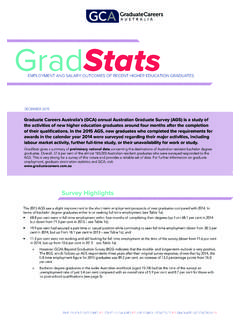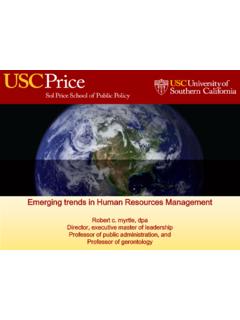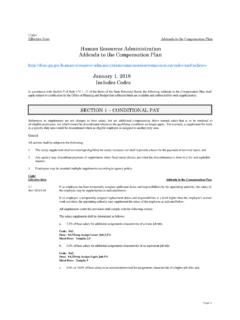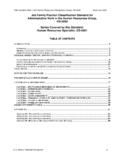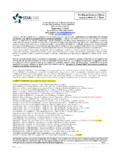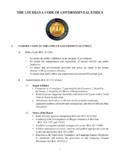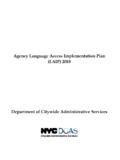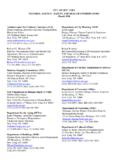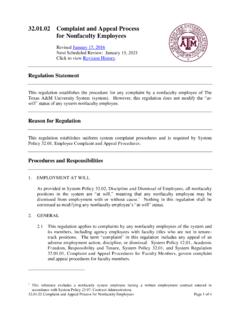Transcription of Careers for
1 Careers forHuman Resources GraduatesAustralian human Resources InstituteContentsIntroduction.. 1 Overview.. 1 Functional Areas of human Resources Management (HRM).. 3 human Resources/Work Force Planning 3 Recruitment and Selection 3 Induction 4 Performance Management 5 Training and Development 5 Remuneration and Benefits 6 Equal Employment Opportunity 7 Occupational Health and Safety 8HR Administration 8 human Resources Information Systems (HRIS) 8 Industrial Relations 9 Organisational Change 10 International HRM 10 Qualifications, Skills and Personal Attributes..10HR Generalists 11 Methods of Entry and Possible career Paths..11 Graduate Profiles ..13 Trends in HRM ..18 Strategic Involvement of HRM 18 Boundaries of HRM 18 Management of Diversity 19 Technology 20 Changing Demographics of the Australian Work Force 20 Future of HRM ..20 Further Information ..21 Professional Associations 21 career Advice 21 Sources and Further Reading 22 Acknowledgments.
2 22 NOTE:Wherever you see this icon please go to >>What Job For You>> career Profiles>> human Resources>>More Information for continued discussion and/or useful websites on that a time of growing international globalisation, there is an increased level of recognition that better management and utilisation of human Resources are the keys to maximising business success. The new millennium is an exciting era for managing people, and the advent of new technologies has increased the need for innovative approaches to the management of those who work both inside and outside their businesses. This booklet provides information about the various functions of the people management profession including areas of specialisation and future growth, the skills and qualities required to embrace such a career and a few tips on the best ways to enter this diverse the past, the generic term for staffing functions within organisations was Personnel. However, Personnel had become only one usually administrative function alongside Industrial Relations, Training, Health and Safety and so on.
3 The increasingly urgent demands for strategic planning for and development of organisations human Resources resulted in widespread adoption of the term human resource Management (HRM).An organisation s human Resources, or human capital, consist of all people employed by an organisation; they are what every organisation depends upon to make it operate. HRM refers to those activities and employees that assist the organisation to meet its stated operational objectives by providing a motivated, well trained work force which understands what the business is about, knows where it fits in within the organisation and how it can contribute to the organisation. HRM deals with recruiting and selecting the most suitable and qualified staff for the organisation; it is concerned with their development, motivation and training in order to minimise turnover and increase performance. Increasingly, HRM is also concerned with the strategic issues associated with people management, with those involved in HRM focussing on organisational change, statutory compliance and industrial matters and performance optimisation.
4 Today HRM professionals work jointly with the Board and senior management team on critical people in human resources //graduate Careers australia // Careers australia // most organisations the HR function covers the following activities:Statutory and Compliance ServicesLegislation governing work arrangement: WorkChoices legislation, Federal and State Awards, Australian Workplace Agreements, RelationsOccupational Health and Safety (OH&S) Equal Employment Opportunity (EEO)Training and DevelopmentLearningClassroomSelf-directe dOn the jobSuccession planningCareer developmentProgram designMentoringStrategic Planning and Organisational ImprovementWork force planningCorporate directionRoles and structuresTeam developmentWorkplace reformKnowledge Management Using Information TechnologyAnalysis of information for decision makingStatistical modellingEvaluation of programsPersonnel ServicesRecruitmentCounsellingTerminatio nPersonnel AdministrationPayrollRecordsRemuneration BenefitsSuperannuationThe range of activities performed by an HRM practitioner varies greatly according to the size and structure of the organisation, the type of industry or field of activity.
5 A company with less than 100 employees may not have an HRM specialist. In this case the management team may carry out the strategic HRM functions while the HR administration is conducted by line managers and other administrative staff. In larger organisations there may be two broad types of HRM practitioners: the generalist and the specialist. The generalist deals with the whole range of HRM functions, while the specialist deals more or less exclusively with one function. While generalists tend to work within organisations, there is a trend towards companies outsourcing certain HR functions with specialist HR practitioners acting as consultants or contractors. As we will see, personnel administration has tended to take a back seat in favour of major areas of specialisation such as Training and Development, Industrial Relations and Occupational Health and roles of human resource practitioners in an organisation are provide a support service and serve as technical advisers to line managers on issues such as recruitment, training and play an important role in defining the HR policies that guarantee fair treatment of all employees, recognition of staff needs and democratic serve an audit role ensuring that managerial decisions agree with the HR policies and are consistent across the explore ways of improving employee productivity and satisfaction, and keep managers informed about changes in employment manage changing business processes brought about by a dynamic business environment, for example business restructures.
6 They provide an ethical and legal understanding of the frameworks required for managing people in various types of business. Senior HR managers provide strategic input into the decision making processes within their build the corporate wisdom of their organisations through staff development and managing human resource information assist the organisation to be customer focused by aligning the needs and requirements of the employees with those of the customers. //HR planning, for example, helps an organisation maximise the use of its current employees and to determine when to take on new employees with the required Areas of human Resources Management (HRM) human Resources/Work Force PlanningThe primary role of the HRM division or department is to help the organisation achieve its objectives. Its most critical function therefore is to work out, in conjunction with other managers, what the business requires of its employees and when this is needed, in both the short and longer term.
7 This sets the framework for all HRM activities, in particular recruitment and selection, and training and development. HR planning involves determining the number of employees and the type of skills required to meet the organisation s short- and long-term objectives. It involves assessing whether employees are properly organised and trained to do what is necessary to implement the corporate strategy. HR planning, for example, helps an organisation maximise the use of its current employees and to determine when to take on new employees with the required skills. It also helps training offices focus their attention on designing training programs supporting the strategy of the and SelectionAttracting and selecting the most suitable and qualified people are the first steps towards organisational effectiveness. Companies are fully aware that recruiting the wrong person can be extremely costly and thus take a great deal of care in selecting new a position is created or becomes vacant, HR practitioners need to develop or review the position description for the role through the process of job analysis and an assessment of required competencies.
8 This requires that they assess where the position fits within the overall structure of the company, determine the appropriate salary range for it, identify the skills and experience levels required and assess the technical and personal competencies desired in the position holder. The HR practitioner should undertake such assessments before they place an advertisement through the organisation s own internal advertising system, via the internet, in a newspaper or through some other sourcing mechanism. The recruiter may opt to use external agencies to assist with the process of attracting and short-listing recruitment, job analysis is the main source of information about the position to be filled and the type of person needed to fill it. Job analysis is the systematic process of identifying the tasks, responsibilities and outcomes of jobs, and the Careers in human resources //3knowledge, skills and abilities required to perform these duties. Job analysis is essentially based on observation by supervisors of the employees carrying out their duties.
9 The result of the job analysis is the position description and personal requirements. Before advertising a vacant position, the HR practitioner and the line manager decide if the position is appropriately graded and check that the position description reflects the needs, role and work value of the departments constantly need to improve the way jobs are advertised so that they attract the right applicants. Applications are then received and acknowledged. On the basis of the specific job requirements, people are short-listed by the HR staff and invited for an interview. An HR manager must know where and how the best candidates are to be found and use the right method to attract the best person for the applications have increasingly become a part of recruitment and selection processes. Such web-based processes can be as simple as accepting a candidate s r sum through the online application system, through to conducting preliminary questioning and testing via an online mechanism.
10 Many organisations are also utilising psychometric testing as a means of determining skills and aptitudes of candidates, and an understanding of the underpinning theory behind such testing is important for those involved in recruitment and on the size of the organisation, a person from HR may be involved to a greater or lesser extent in the interviewing and selection process. Generally, although a person from HRM may be involved in the interviewing process, the final decision rests in the hands of the manager who will work with the person (the line manager). The role of the HR practitioner in the selection process includes designing an interview guide for line managers, ensuring that the recruitment process complies with the legislative requirements and ensuring that applicants are assessed solely on their merits and not discriminated against. In other organisations, it will be the responsibility of the HR practitioner to actually conduct the interview and select a short-list of preferred candidates for final assessment by others.





